What Is Addiction?

In this article
Although addiction is a common problem, it’s one of the most misunderstood health conditions. Most people associate the word addiction with dependence on a substance, such as alcohol and drugs.
However, substances aren’t the only things that people abuse or think they’re addicted to. Behaviors like gambling or shopping can also become addictive and lead to loss of control and seeking the activity despite all negative consequences.
Keep reading to learn about how to recognize the physical, mental, and emotional signs of different types of addiction and how to treat them. We’ll also talk about the causes of addiction and how to help yourself or someone you love through the road to recovery.
What is addiction?
In the past, addiction was considered to be the result of a character flaw, weakness, moral failing, or a choice, so addiction issues came with a lot of blame and shame; but after nearly a century of scientific study, researchers have come to a deeper understanding of how it works. [1] Biology of Addiction. (2024, June 17). NIH News in Health. https://newsinhealth.nih.gov/2015/10/biology-addiction
Now, addiction is classified as a chronic, relapsing disease that affects the brain and is defined by a physical and psychological dependence on alcohol, drugs, or behavior.
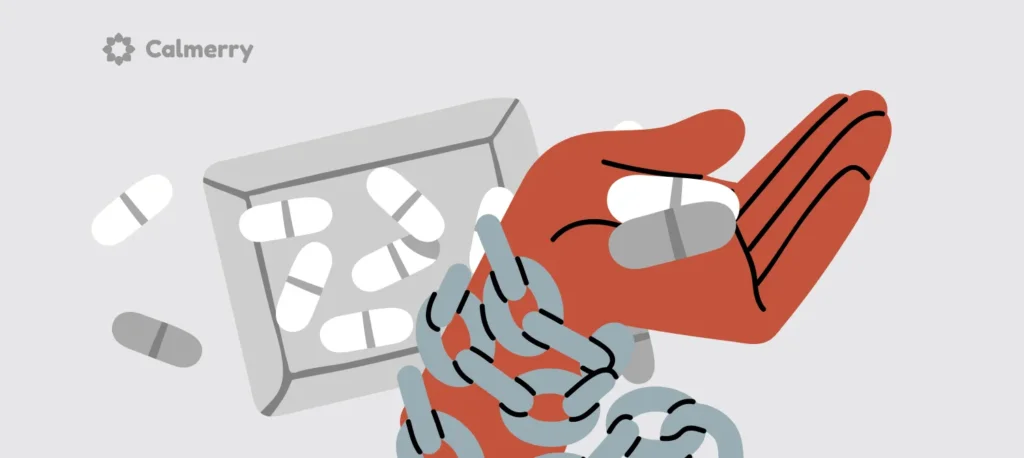
The consequences of addiction can be devastating for both an addict and the people they love, so it’s crucial to reach out for help.
Although breaking an addiction is tough, it can be done with the correct treatment and support. It’s also important to understand what you or your loved ones may be dealing with and why.
Why do people become addicted?
There are different reasons why someone would try a substance or behavior. Some may do it because of social pressure or curiosity, while others are looking for a way to relieve stress and feel better.
Nobody plans to develop an addiction. There are biological, environmental, and life experience-related factors that can contribute to the development of addiction.
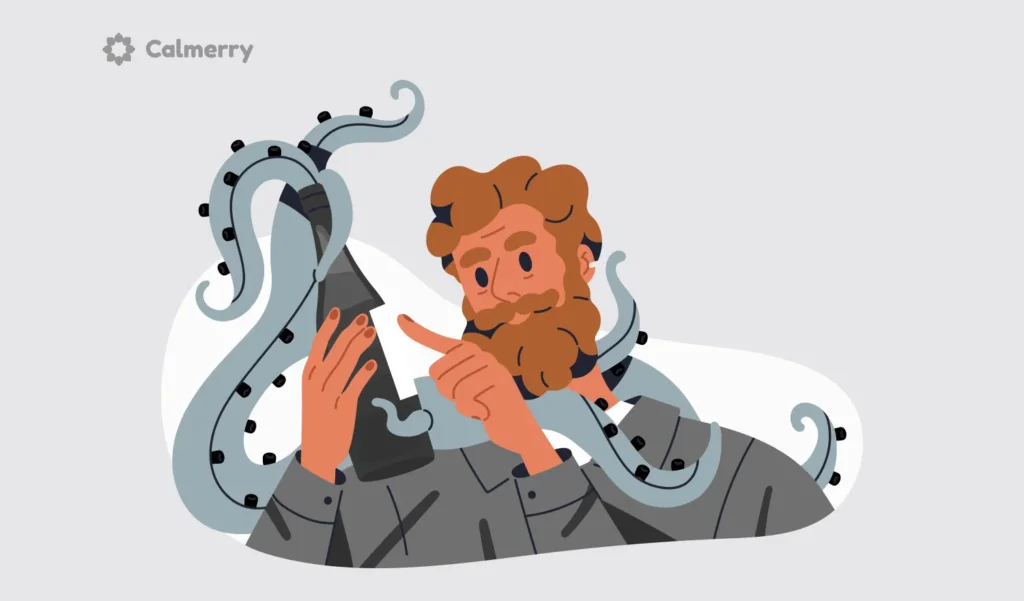
That means that some people are more predisposed to developing an addiction than others, just like with any other health condition. The more risk factors someone has, the higher the possibility of developing a disease is.
Risk factors of addiction
Understanding the risk factors of addiction can help us protect ourselves and our loved ones.
Let’s explore some common factors that can increase the chances of developing an addiction.
Genetics
If you have a family history of addiction, you are more likely to become addicted to something than someone who doesn’t. Although there is no such thing as an addiction gene, you may inherit a genetic vulnerability to addiction.
Studies suggest that genetic factors can account for at least half of a person’s susceptibility to drug addiction. [2] Price, M. (n.d.). Genes matter in addiction. https://www.apa.org. https://www.apa.org/monitor/2008/06/genes-addict
Environmental factors
Connection to family and friends, quality of life, economic status, and culture contribute to developing addiction as well. Experiencing trauma, abuse, neglect, or witnessing domestic violence at an early age, living in isolation, and having low socioeconomic status can greatly affect a person’s risk of developing an addiction.
Development
Addiction can occur at any age, but using substances at an early age or earlier exposure to addictive behaviors can put a person at greater risk of becoming addicted. That happens because areas in our brains responsible for decision-making, judgment, and self-control are still developing in young people.
Underlying mental health conditions
People with mental health disorders are more likely to develop substance use disorder than the general population. For example, a significant number of people with addiction also have co-occurring depression or anxiety.
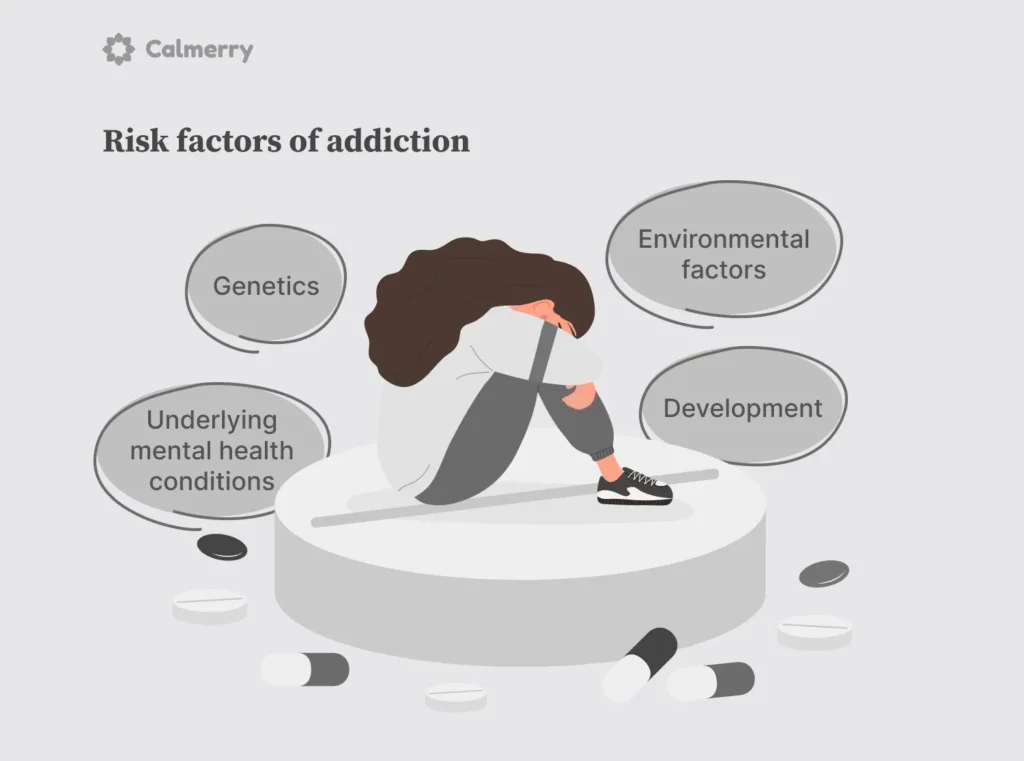
Addiction and the brain
Today, addiction is recognized as a chronic disease that hijacks the brain and changes both its structure and function. Most drugs and addictive behaviors affect the brain’s reward system, causing a particularly powerful surge of the neurotransmitter dopamine, which results in euphoria or a “high.”
The desire to experience this euphoria again triggers cravings for the substance or behavior, and that’s the first sign of addiction. Over time, the brain adapts by producing less dopamine or eliminating dopamine receptors and reducing the ability of the reward circuit to respond.
You may discover that the desired substance no longer gives you as much pleasure, so you have to take more of it to obtain the same dopamine “high”. This effect is called tolerance.
It can also make people experience uncomfortable withdrawal symptoms if they stop or reduce consuming an addictive drug or engaging in an activity.
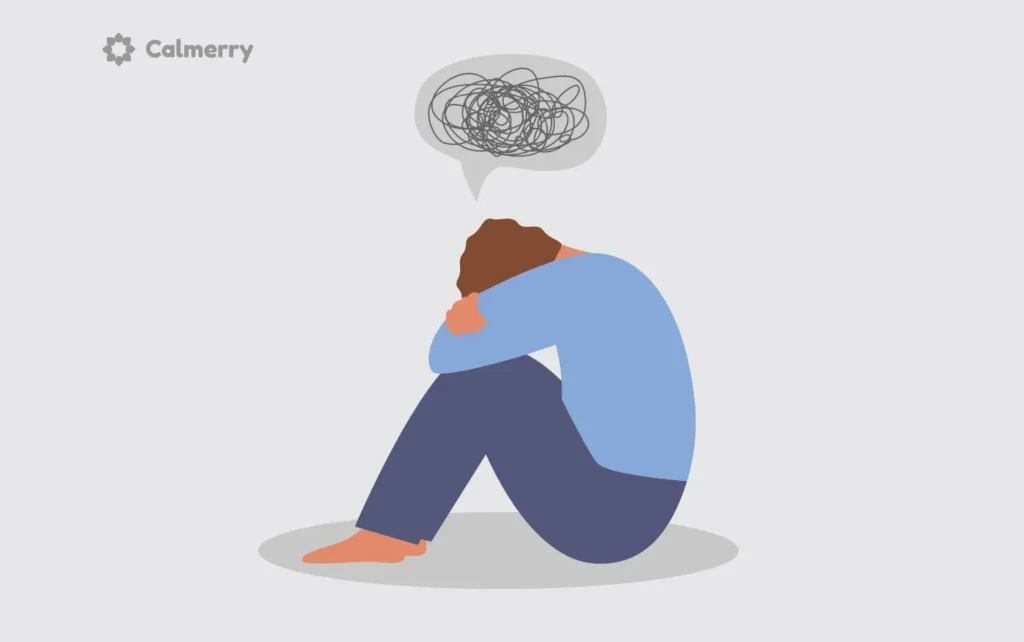
Because of these brain adaptations, people with addiction may end up consuming more of a drug or addictive activity to get the same “high” and avoid unpleasant withdrawal symptoms.
Over time, this can reduce their ability to feel pleasure from other things they once enjoyed, such as making art or engaging in hobbies, and result in loss of control over substance use or specific behaviors. People who develop addiction often can’t quit the substance or behavior despite their best efforts.
Addicts become obsessed with whatever they are addicted to, and it becomes the most important thing in their life. They may neglect other responsibilities to their spouse, children, work, friends, and even their own self-care.
Because of the need to satisfy the craving, they can start cheating and hurting those they love. People who develop addiction will continue with their destructive behavior despite the fact there will be negative consequences.
What are the types of addiction?
Addiction can manifest in two ways: overusing or misusing physical substances or excessively engaging in behaviors despite the negative consequences.
These two types of addiction are typically recognized as chemical or behavioral. Both types of addiction share similar features, but there are also some key differences.
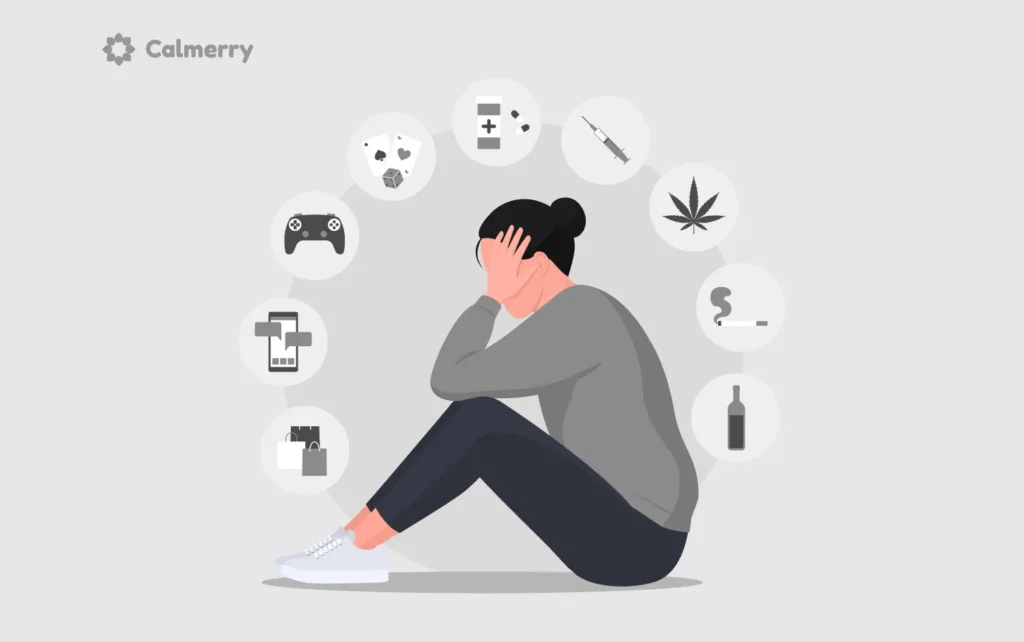
Chemical addictions
Chemical addiction is often what most people think of when they talk about addiction in general. It involves the addiction to such substances as alcohol, tobacco, prescription drugs, cocaine, cannabis, methamphetamine, etc.
Regardless of the type of substance, continued chemical addiction causes serious problems in virtually every aspect of life.
Addictive substances have different effects on our bodies and our brains. In particular, substances alter the way the brain sends, receives, or processes information. They can either mimic our natural brain chemicals or overstimulate our brain’s reward system.
Changes in brain structure and function are fundamental to the development of addiction and lead to compulsive behavior, cravings, and withdrawal symptoms. They can result in learning and memory problems as well as personality changes.
Brain changes from chronic substance use can persist years after a person quits. This is why there’s a risk of relapse even after long periods of abstinence, and despite a relapse’s potentially devastating effects.
Characteristics of substance addiction also include frequent intoxication, hangover, illness, and physical side effects, such as damage to major organ systems. Intoxication is not always externally and behaviorally obvious to the individual themselves or others around them.
An individual may have a high level of intoxication and still appear as if they are functioning within their daily social roles.
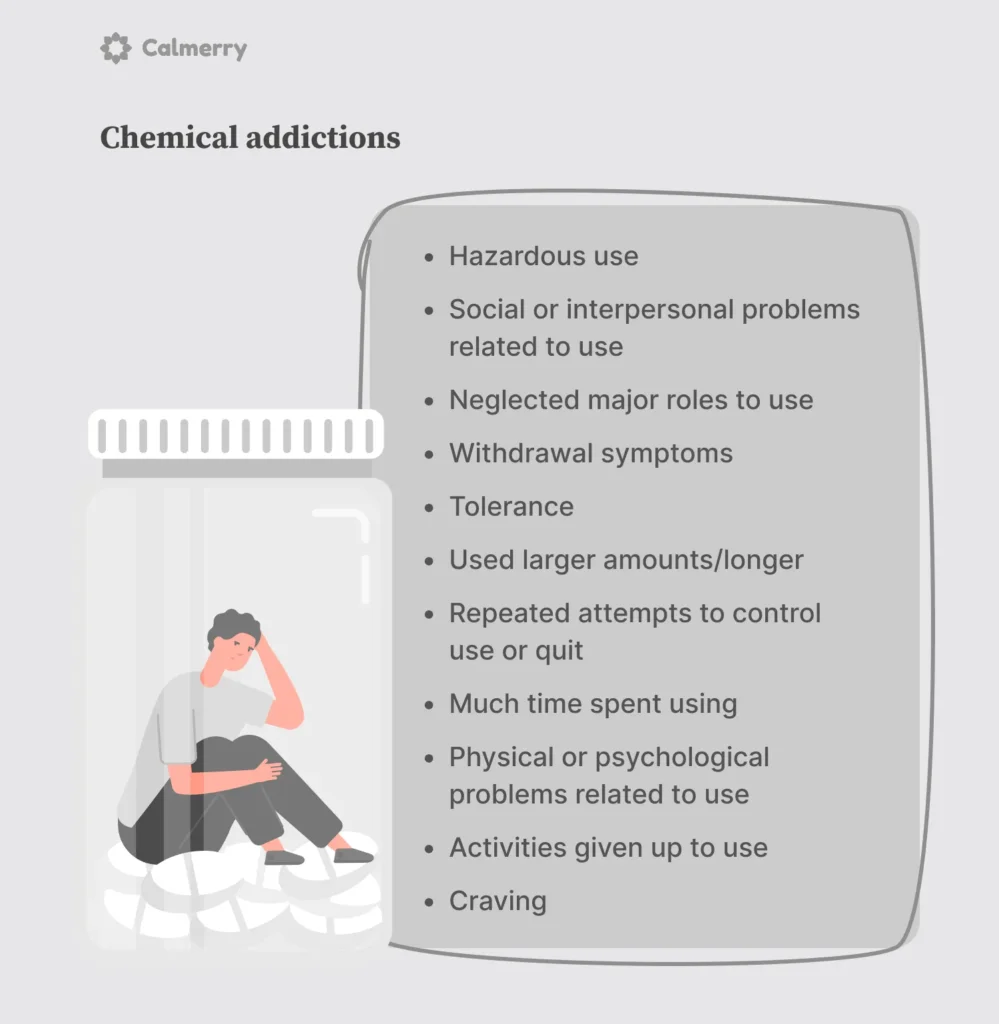
The signs of a substance addiction vary widely from person to person and depend on the substance, particular patterns of use and tolerance, and an individual’s personality. This means that there are no set common signs of addiction because everyone will display different physical, psychological, and behavioral symptoms.
When people talk about chemical addiction, there’s often confusion around such terms as substance misuse/abuse, dependency, and addiction. The Diagnostic and Statistical Manual of Mental Disorders (DSM-5), published by the American Psychiatric Association, recommends using the term substance use disorder.
There are eleven DSM-5 criteria that fall under four basic categories – impaired control, physical dependence, social problems, and risky use: [3] Hasin, D. S., O’Brien, C. P., Auriacombe, M., Borges, G., Bucholz, K., Budney, A., Compton, W. M., Crowley, T., Ling, W., Petry, N. M., Schuckit, M., & Grant, B. F. (2013). DSM-5 Criteria for Substance Use Disorders: Recommendations and Rationale. The American Journal of Psychiatry, 170(8), 834–851. https://doi.org/10.1176/appi.ajp.2013.12060782
- Hazardous use: using the substance in situations that may be unsafe, for example, driving while under the influence of the substance
- Social or interpersonal problems related to use: continuing to use the substance even when it causes relationship problems because of substance use
- Neglected major roles to use: not meeting obligations and responsibilities at work, home, or school
- Experiencing withdrawal symptoms when you stop using the substance
- Tolerance: needing more of the substance to get the desired effect
- Used larger amounts/longer: taking larger amounts of the substance over a longer period of time than you intended
- Repeated attempts to control use or quit: trying to cut down or stop using the substance but being unable to
- Much time spent using: spending more time getting and using drugs and recovering from substance use
- Physical or psychological problems related to use: continuing to use the substance, even though you know it’s causing you physical or psychological harm
- Activities given up to use: giving up important or desirable social and recreational activities due to substance use
- Craving: experiencing intense cravings or urges to use the substance
Medical professionals use diagnostic criteria outlined in DSM-5 to differentiate between mild, moderate, and severe cases of substance use disorders.
If you meet two or three of the criteria within a 12-month period, you have a mild substance use disorder.
Four to five criteria indicate moderate substance use disorder, and if you meet six or more criteria, it points to a severe substance use disorder.
Behavioral addictions
While the only recognized behavioral addiction in the DSM-5 is gambling disorder, public opinion and many mental health professionals recognize that certain behaviors that give us pleasure and enjoyment can also become addictive.
People can form behavioral addictions to specific activities, like shopping or sex, to seek out feelings of comfort and happiness and/or escape reality to cope with painful emotions caused by underlying mental health challenges.
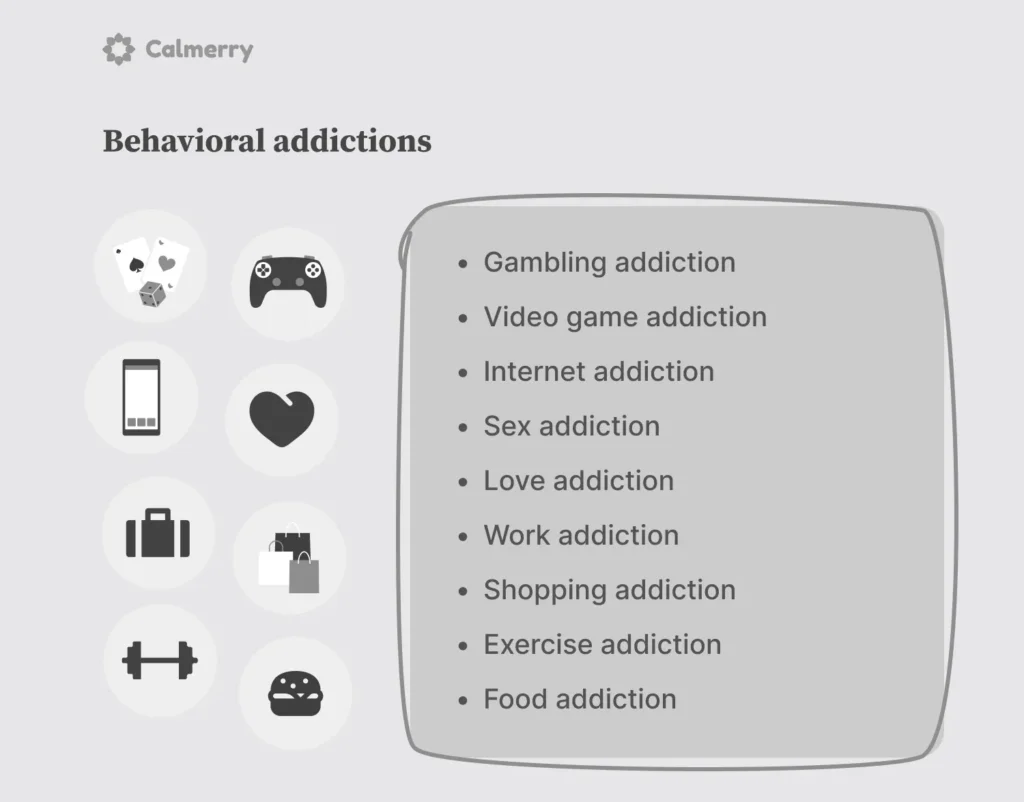
The negative effects of a behavioral addiction can be similar to those related to a substance use disorder. People with behavioral addictions compulsively participate in the behavior over and over again to seek “high” or pleasure, no matter the consequences and can’t quit without outside help.
After repeated use, people build a tolerance, and if they try to stop or decrease the behavior, they may experience withdrawal symptoms, such as unpleasant emotions, including irritability or anxiety. Behavioral addictions also lead to conflicts with others or with self.
Some of the most common types of behaviors that are or could be considered addictions are:
- Gambling addiction is characterized by a compulsion to visit casinos, buy lottery tickets, bet on sports, and play slot machines despite any negative consequences
- Video game addiction, also known as internet gaming disorder, which the DSM-5 recognizes as a condition for further study; it’s characterized by reduced control over gaming
- Internet addiction is used to describe excessive internet use and a compulsion to be online; people with this addiction face adverse consequences like irritability, anxiety, and depression when not using it
- Sex addiction is characterized by a need to engage in sexual acts regardless of the risks or negative consequences
- Love addiction is a controversial and highly debatable condition that causes a person to develop an unhealthy and obsessive fixation with a love interest. [4] Earp, B. D., Wudarczyk, O. A., Foddy, B., & Savulescu, J. (2017). Addicted to Love: What is love addiction and when should it be treated? Philosophy, Psychiatry & Psychology, 24(1), 77–92. https://doi.org/10.1353/ppp.2017.0011 People commonly use this phrase to describe feeling excessively dependent on their romantic partners.
- Work addiction: some people become obsessed with their work to the extent that they become physically exhausted
- Shopping addiction involves compulsively buying things you don’t need as a way to mask or get relief from negative feelings
- Exercise addiction describes an unhealthy obsession with participating in different exercise and fitness activities to the point that they become harmful physiologically and psychologically
- Food addiction is a relatively new and controversial term that refers to compulsively eating food to ease negative feelings and emotions.
The American Psychiatric Association (APA) doesn’t include these behavior patterns in the DSM-5, except the gambling disorder, due to the lack of scientific, peer-reviewed evidence that is necessary for developing standard criteria for diagnosis.
However, general signs of a potential behavioral addiction include:
- Being preoccupied with the behavior
- Using the behavior to avoid negative emotions
- Feeling shame or embarrassment after engaging in the activity
- Excessively participating in the behavior even if it negatively affects everyday life, responsibilities, or relationships
- Feeling out of control while engaging in the behavior
- Withdrawal symptoms such as irritability, restlessness, anxiety, and depression when trying to quit.
Stages of addiction
Addiction is a chronic disease that doesn’t happen overnight, it tends to develop gradually. The process of developing an addiction to a substance or activity tends to occur over a series of stages.
People who develop addictions tend to follow the same path and go through the same stages that can occur over a short period of time or they can take months to develop.
Understanding these four stages of addiction is a critical step in recognizing that you or your loved one may have a problem and seeking help:
- Experimentation: using a substance or engaging in a behavior out of curiosity or to cope with stresses of everyday life
- Regular use: using a substance or engaging in activity in social situations or for social reasons
- Problem or risk use: continuing using a substance or engaging in a behavior in spite of serious social or legal consequences
- Dependency: losing control and using a substance or engaging in a behavior on a daily basis, or several times per day; experiencing withdrawal symptoms when trying to quit.
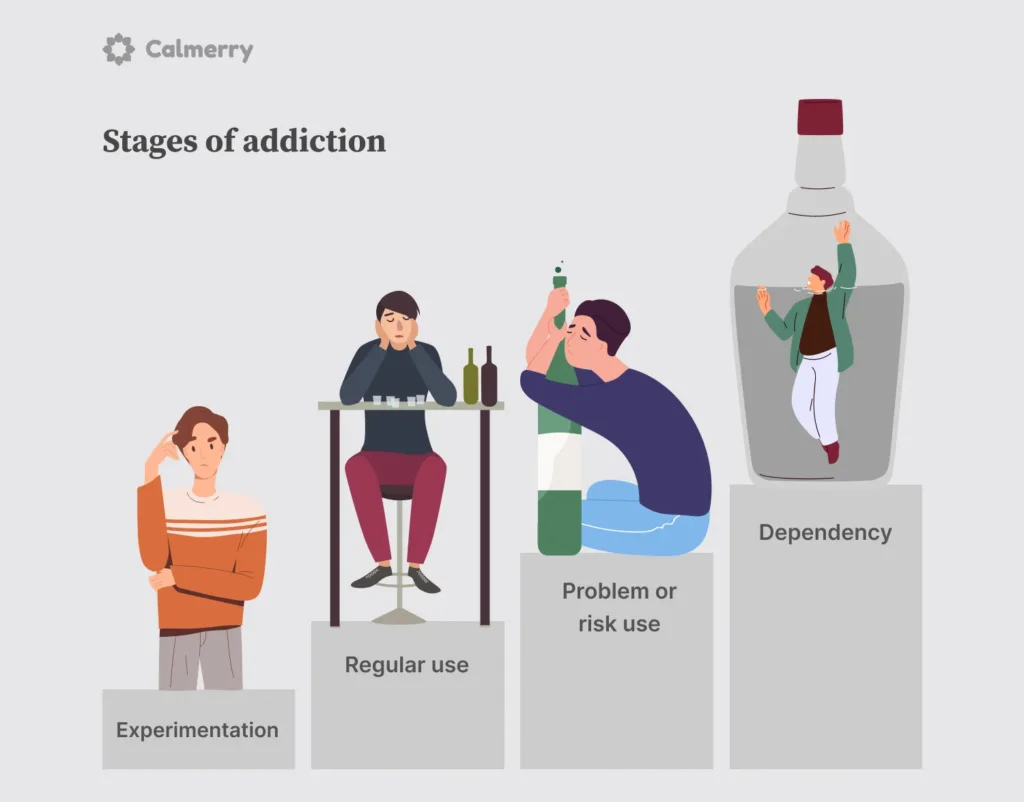
What are the consequences?
If left untreated, addiction can lead to a range of serious psychological, physiological, and personal effects. The complications often depend on the type of substance or behavior.
For example, sex addiction greatly increases the risk of contracting sexually transmitted diseases (STDs). Smoking tobacco can cause many cancers, and sharing non-sterilized needles while injecting intravenous drugs can lead to the transmission of HIV, hepatitis C, and other harmful infections.
Addiction negatively affects all areas of a person’s life, and long-term consequences can be:
- Physical, such as injuries, skin abscesses, spikes in blood pressure, heart attack, HIV/AIDS, neurological damage, overdose, death
- Psychological, such as stress, restlessness, guilt, shame, loneliness, anxiety, depression, psychosis, and other mental health problems
- Social, such as damaged relationships with friends and family, divorce, loss of job, dropping out of school, crime, being a perpetrator or a victim of abuse, legal problems
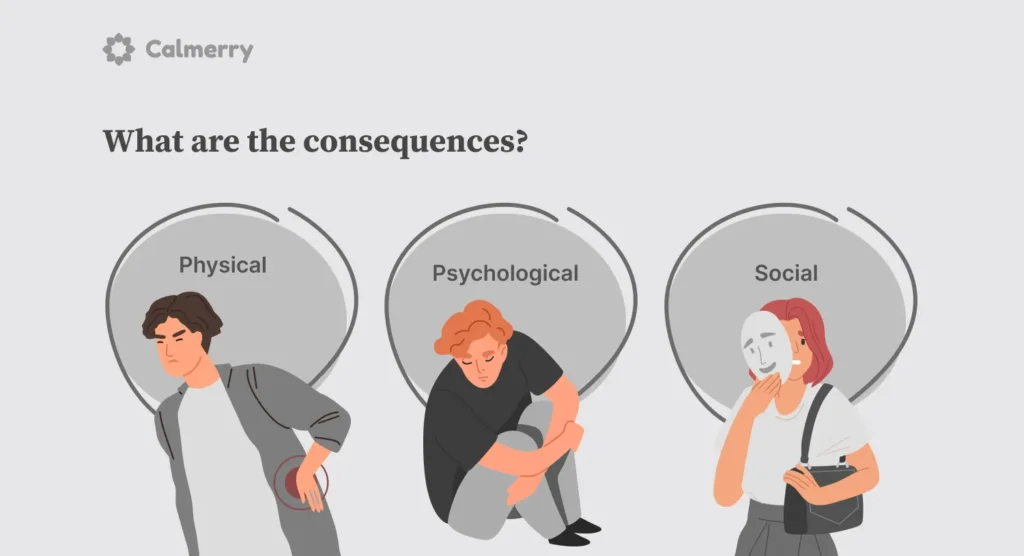
Treatment options for addictions
All types of addictions are highly treatable, and there are many effective treatment options that can help people break free of addiction. Some models focus on complete abstinence while others – on harm reduction.
The choice of treatment strategies will depend on several factors, including the type of addictive disorder, its length and severity, and its effects on the person. You may need a combination of different treatment approaches, multiple rounds of treatment, and even lifelong management.
In case of severe chemical addiction, a person will need to check into a medical detox treatment facility and be monitored by medical professionals while their body clears from an addictive substance. Medically assisted detox helps limit unpleasant withdrawal reactions.
However, detox doesn’t treat the underlying behavioral causes of the addiction, so it is followed by treatments that address psychological aspects of addiction.
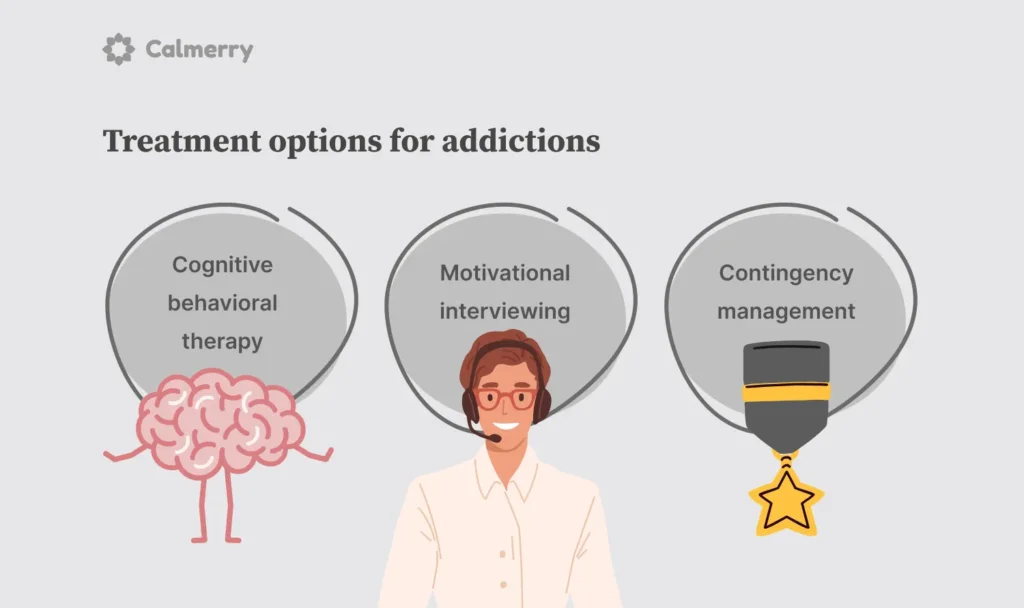
Treating chemical addiction can include a variety of approaches, such as medications to help with withdrawal, cravings, depression, and anxiety if needed, and individual, group, or family psychotherapy.
Psychologists have developed many evidence-based treatments for chemical addiction that help a person learn strategies to break the cycle:
- Cognitive behavioral therapy (CBT) can help addicted patients recognize and avoid destructive thoughts and behaviors. A therapist will teach them to recognize the triggers that cause their craving for alcohol, drugs, or nicotine and then avoid or manage those triggers.
- Motivational interviewing is a technique of changing ambivalent behaviors. It can help people with addiction increase their motivation to overcome substance abuse and be willing to make adjustments to their behavior.
- Contingency management is a behavioral treatment that reinforces desired behaviors through incentives. Patients are rewarded for meeting a treatment goal and providing evidence of positive behavioral change to encourage them to stay off drugs.
Treatment for behavioral addictions is centered around psychotherapy, in both individual and group formats, but it can also include medication. Many therapeutic approaches used to treat substance abuse can be successfully used to treat behavioral addiction.
Common approaches include cognitive behavioral therapy and motivational interviewing. The goal of treatment is to change the thought patterns and patterns of behavior and develop new coping skills.
There are many treatment centers that specialize in helping people with specific behavioral issues and support groups for people working toward recovery. Online therapy can also be a viable option for people dealing with addiction.
How to overcome addiction
Making change is difficult, and it takes more than willpower or desire to overcome addiction to drugs, alcohol, or behavior.
The first and the toughest step is recognizing that you have a problem, deciding to make a change, and seeking help.

At this stage, it’s particularly helpful to consult a doctor, an addiction counselor, or a psychologist. They can help you understand the risks of withdrawal and what can help alleviate them. They can also advise you on treatment settings that may be best for your needs and on how to proceed with getting the help you need.
It’s also important to create a support network. Talk to your family and friends about your plan and ask for their encouragement and support with your goals.
You’ll feel more encouraged when facing difficulties if you know there are people who are ready to help you cope with the challenges of quitting.
Final thoughts
Addiction is not a choice or a moral failing; it’s a chronic, complex brain disease that can seriously interfere with your daily life and lead to long-term psychological, physiological, and social consequences.
Fortunately, addiction is treatable, and there are many effective treatments that can help set you on a successful path to recovery.

Researchers have developed effective behavioral and pharmaceutical therapies to help people break free from addiction. Some of the most strongly supported evidence-based behavioral treatments for substance use disorder and behavioral addiction include cognitive behavioral therapy, motivational interviewing, and contingency management.
When it comes to overcoming addiction, it’s a long journey, and there is no one-size-fits-all approach. Psychotherapy, medications, support groups, and lifestyle changes may play a role in your recovery, but it’s important to find the approach that works best for your needs.
If you’re struggling with addiction, Calmerry has professionals specializing in substance and behavioral addiction who can help you cope with the issues. Remember, there is nothing wrong with you; sometimes, you just need a tiny push to find the way out, and online therapy is a good beginning.
Biology of Addiction. (2024, June 17). NIH News in Health. https://newsinhealth.nih.gov/2015/10/biology-addiction
Price, M. (n.d.). Genes matter in addiction. https://www.apa.org. https://www.apa.org/monitor/2008/06/genes-addict
Hasin, D. S., O’Brien, C. P., Auriacombe, M., Borges, G., Bucholz, K., Budney, A., Compton, W. M., Crowley, T., Ling, W., Petry, N. M., Schuckit, M., & Grant, B. F. (2013). DSM-5 Criteria for Substance Use Disorders: Recommendations and Rationale. The American Journal of Psychiatry, 170(8), 834–851. https://doi.org/10.1176/appi.ajp.2013.12060782
Earp, B. D., Wudarczyk, O. A., Foddy, B., & Savulescu, J. (2017). Addicted to Love: What is love addiction and when should it be treated? Philosophy, Psychiatry & Psychology, 24(1), 77–92. https://doi.org/10.1353/ppp.2017.0011
online therapy
live video session



